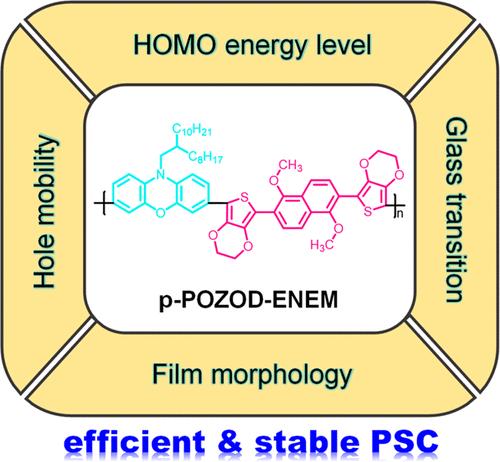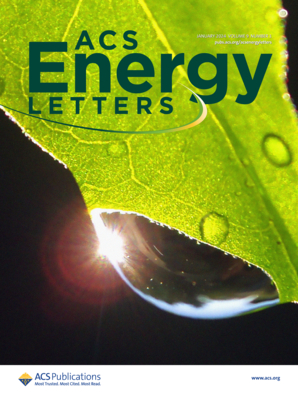A Phenoxazine-Based Alternating Copolymer for Efficient and Durable Perovskite Solar Cells
IF 19.3
1区 材料科学
Q1 CHEMISTRY, PHYSICAL
引用次数: 0
Abstract
Developing cost-effective p-type semiconducting polymers with desirable electrical properties and thermal tolerance is essential for the practical application of n-i-p type perovskite solar cells. In this study, we synthesized a semiconducting copolymer, p-POZOD-ENEM, via direct arylation polycondensation. This copolymer features an alternating main chain of phenoxazine, ethylenedioxythiophene, dimethoxynaphthalene, and ethylenedioxythiophene. The theoretical HOMO energy level of p-POZOD-ENEM is 70 meV deeper than that of the homopolymer poly(10-(2-octyldodecyl)phenoxazine-3,7-diyl) (p-POZOD), yet both are comparable to the established material spiro-OMeTAD. Furthermore, p-POZOD-ENEM exhibits higher glass transition temperature, hole mobility, and conductivity than both p-POZOD and spiro-OMeTAD, along with enhanced film morphology. Perovskite solar cells utilizing p-POZOD-ENEM as the hole transport material achieved an average power conversion efficiency of 25.0% and maintained good stability under thermal storage at 85 °C and operation at 45 °C.

一种基于吩嗪的交替共聚物,可用于高效耐用的 Perovskite 太阳能电池
开发具有理想电学特性和耐热性的高性价比 p 型半导体聚合物对于 ni-p 型过氧化物太阳能电池的实际应用至关重要。在这项研究中,我们通过直接芳基化缩聚合成了一种半导体共聚物 p-POZOD-ENEM。这种共聚物的主链由吩嗪、亚乙基二氧噻吩、二甲氧基萘和亚乙基二氧噻吩交替组成。对-POZOD-ENEM 的理论 HOMO 能级比均聚物聚(10-(2-辛基十二烷基)吩恶嗪-3,7-二基)(对-POZOD)的 HOMO 能级深 70 meV,但二者的能级都可与成熟材料螺-OMeTAD 相媲美。此外,与 p-POZOD 和螺-OMeTAD 相比,p-POZOD-ENEM 表现出更高的玻璃化转变温度、空穴迁移率和电导率,同时薄膜形态也得到了改善。使用 p-POZOD-ENEM 作为空穴传输材料的 Perovskite 太阳能电池实现了 25.0% 的平均功率转换效率,并在 85 °C 的热储存和 45 °C 的运行条件下保持了良好的稳定性。
本文章由计算机程序翻译,如有差异,请以英文原文为准。
求助全文
约1分钟内获得全文
求助全文
来源期刊

ACS Energy Letters
Energy-Renewable Energy, Sustainability and the Environment
CiteScore
31.20
自引率
5.00%
发文量
469
审稿时长
1 months
期刊介绍:
ACS Energy Letters is a monthly journal that publishes papers reporting new scientific advances in energy research. The journal focuses on topics that are of interest to scientists working in the fundamental and applied sciences. Rapid publication is a central criterion for acceptance, and the journal is known for its quick publication times, with an average of 4-6 weeks from submission to web publication in As Soon As Publishable format.
ACS Energy Letters is ranked as the number one journal in the Web of Science Electrochemistry category. It also ranks within the top 10 journals for Physical Chemistry, Energy & Fuels, and Nanoscience & Nanotechnology.
The journal offers several types of articles, including Letters, Energy Express, Perspectives, Reviews, Editorials, Viewpoints and Energy Focus. Additionally, authors have the option to submit videos that summarize or support the information presented in a Perspective or Review article, which can be highlighted on the journal's website. ACS Energy Letters is abstracted and indexed in Chemical Abstracts Service/SciFinder, EBSCO-summon, PubMed, Web of Science, Scopus and Portico.
文献相关原料
| 公司名称 | 产品信息 | 采购帮参考价格 |
|---|
 求助内容:
求助内容: 应助结果提醒方式:
应助结果提醒方式:


